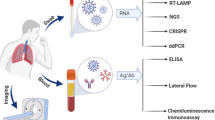Abstract
Cryptosporidium parvum is a widely distributed coccidian parasite and causes enteric disease in humans and animals. In addition to being a cause of life-threatening disease in immunodeficient people, mostly AIDS patients, C. parvum has been reported as a common serious primary cause of outbreaks of diarrhea in newborn calves, especially newborn ruminants (De Graaf et al. in Int J Parasitol 29:1269–1287, 1999). To obtain the recombinant P23 protein, we isolated the mRNA from oocyst of C. parvum and amplified the cDNA of P23 gene by reverse transcriptase PCR. Sequencing of cDNA showed 100% homology to the known P23 sequences. The double strand P23-cDNA was then cloned in pGEX-5X-2 expression vector. Western blot analysis of recombinant P23 showed that it could be recognized by the positive C. parvum serum. Since P23 is an immunodominant surface glycoprotein expressed in the early phase of infection (Jakobi and Petry in Microbes Infect 8:2186–2194, 2006) and the immunogenic epitopes are also found in the residual chain of amino acid sequence of this glycoprotein, the recombinant P23 was used for the screening of 437 serum samples collected from calves (#264) and cattle (#173). The dot blot analysis showed that from 264 calf and 173 cattle sera, 33% and 37% sera were positive, respectively. Due to the simple handling and equipment, dot blot analysis with P23 could be recommended for calves screening against cryptosporidiosis.

Similar content being viewed by others
References
De Graaf DC, Vanopdenbosch E, Ortega-Mora LM, Abbassi H, Peeters JE (1999) A review of the importance of cryptosporidiosis in farm animals. Int J Parasitol 29:1269–1287
Fayer R (1997) Cryptosporidium and cryptosporidiosis. CRC, NewYork
Harp JA, Goff JP (1995) Protection of calves with a vaccine against Cryptosporidium parvum. J Parasitol 81(1):54–57
Jakobi V, Petry F (2006) Differential expression of Cryptosporidium parvum genes encoding sporozoite surface antigens in infected HCT-8 host cells. Microbes Infect 8:2186–2194
Jenkins MC, Fayer R, Tiley M, Upton SJ (1999) Cloning and expression of a cDNA encoding epitopes shared by 15- and 60-kilodalton proteins of Cryptosporidium parvum sporozoites. Infect Immunol 61(6):2377–2382
Lorenzo MJ, Ares-Mazas E, villacorta Martinez de Maturana I (1993) Detection of oocysts and IgG antibodies to Cryptosporidium parvum in asymptomatic adult cattle. Vet Parasitol 47:9–15
Perryman LE, Kapil SJ, Jones ML, Hunt EL (1999) Protection of calves against cryptosporidiosis with immune bovine colostrum induced by a Cryptosporidium parvum recombinant protein. Vaccine 17(17):2142–2149
Pohlenz J, Moon HW, Cheville NF, Bemrick WJ (1978) Cryptosporidiosis as a probable factor in neonatal diarrhea of calves. J Am Vet Med Ass 172:452–457
Reperant JM, Naciri M, Iochmann S, Tilley M, Bout DT (1994) Major antigens of Cryptosporidium parvum recognized by serum antibodies from different infected animal species and man. Vet Parasitol 55:1–13
Santin M, Trout JM, Xiao L, Zhou L, Greiner E, Fayer R (2004) Prevalence and age-related variation of Cryptosporidium species and genotypes in dairy calves. Vet Parasitol 122:103–117
Shirafuji H, Xuan X, Kimata I, Takashima Y, Fukumoto S, Otsuka H, Nagasawa H, Suzuki H (2005) Expression of p23 Cryptosporidium parvum in Toxoplasma gondii and evaluation of its protective effects. J Parasitol 91(2):476–479
Takashima Y, Xuan X, Kimata I, Iseki M, Kodama Y, Nagane N, Nagasawa H, Matsumoto Y, Mikami T, Otsuka H (2003) Recombinant bovine herpesvirus-1 expressing p23 protein of Cryptosporidium parvum induces neutralizing antibodies in rabbits. J Parasitol 89(2):276–282
Tennant B, Harrold D, Reina-Guerra M, Laben RC (1969) Neonatal alterations in serum gamma globulin levels of Jersey and Holstein–Friesian calves. Am J Vet Res 30:345–354
Wang HF, Swain JB, Besser TE, Jasmer D, Wyatt C (2003) Detection of antibodies to a recombinant Cryptosporidium parvum P23 in serum and feces from neonatal calves. Parasitol 89(5):918–923
Weaver DM, Tyler JW, Van Metre DC, Hostetler DE, Barrington GM (2000) Passive transfer of colostral immunoglobulins in calves. J Vet Internal Med 14:569–577
Wyatt CR (2000) Cryptosporidium parvum and mucosal immunity in neonatal calves. Anim Health Res Rev 1:25–34
Xiao L, Escalante L, Yang C, Sulaiman I, Escalante AA, Montali RJ, Fayer R, Lal AA (1999) Phylogenic analysis of Cryptosporidium parasites based on the small-subunit rRNA gene locus. Appl Environ Microbial 65:1578–1583
Acknowledgements
We thank the Iran National Science Foundation for financial support of grant no. 84112/31 and Investigating Unit “Molecular Biological System Transfer” (MBST) for technical supports. We also thank Narges Amini for technical assistance.
Author information
Authors and Affiliations
Corresponding author
Rights and permissions
About this article
Cite this article
Shayan, P., Ebrahimzadeh, E., Mokhber-Dezfouli, MR. et al. Recombinant Cryptosporidium parvum p23 as a target for the detection of Cryptosporidium-specific antibody in calf sera. Parasitol Res 103, 1207–1211 (2008). https://doi.org/10.1007/s00436-008-1117-y
Received:
Accepted:
Published:
Issue Date:
DOI: https://doi.org/10.1007/s00436-008-1117-y




